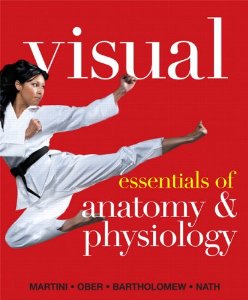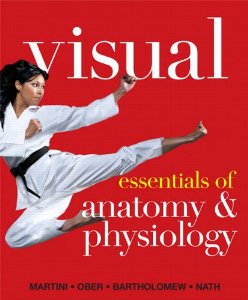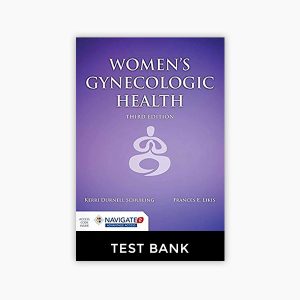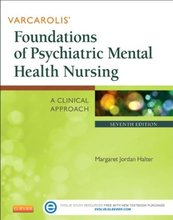This is completed downloadable of Test Bank for Visual Essentials of Anatomy and Physiology: Martini

Product Details:
- ISBN-10 : 0321780779
- ISBN-13 : 978-0321780775
- Author:
Visual Essentials of Anatomy & Physiology combines a visual approach with a modular organization to deliver an easy-to-use and time-efficient book that uniquely meets the needs of today’s students―without sacrificing the coverage of A&P topics required for careers in nursing and other allied health professions. This book is geared toward students enrolled in a one–semester A&P course.
Table of Content:
- 1 An Introduction to Anatomy and Physiology
- SECTION 1 A&P in Perspective
- 1.1 Anatomy is the study of form; physiology is the study of function
- 1.2 Form and function are interrelated
- 1.3 The human body has multiple interdependent levels of organization
- 1.4 Organs and organ systems perform vital functions
- Section 1 Review
- SECTION 2 Homeostasis
- 1.5 Negative feedback provides stability, whereas positive feedback accelerates a process to complet
- Section 2 Review
- SECTION 3 Anatomical Terms
- 1.6 Superficial anatomy and regional anatomy indicate locations on or in the body
- 1.7 Directional and sectional terms describe specific points of reference
- 1.8 Body cavities protect internal organs and allow them to change shape
- Section 3 Review
- Chapter 1 Review
- Visual Outline with Key Terms
- Career Paths: Diagnostic Medical Sonographer
- Chapter 1 Review Questions
- 2 Chemical Level of Organization
- SECTION 1 Atoms and Molecules
- 2.1 Typical atoms contain protons, neutrons, and electrons
- 2.2 Electrons occupy various energy levels
- 2.3 The most common chemical bonds are ionic bonds and covalent bonds
- Section 1 Review
- SECTION 2 Chemical Reactions
- 2.4 Chemical notation describes chemical reactions that may be helped by enzymes
- 2.5 There are three basic types of chemical reactions
- Section 2 Review
- SECTION 3 The Importance of Water in the Body
- 2.6 Physiological systems depend on water
- 2.7 Regulation of body fluid pH is vital for homeostasis
- Section 3 Review
- SECTION 4 Metabolites and Nutrients
- 2.8 Carbohydrates contain carbon, hydrogen, and oxygen, usually in a 1:2:1 ratio
- 2.9 Lipids often contain a carbon-to-hydrogen ratio of 1:2
- 2.10 Steroids, phospholipids, and glycolipids have diverse functions
- 2.11 Proteins are formed from amino acids
- 2.12 Enzymes are proteins with important regulatory functions
- 2.13 High-energy compounds may store and transfer a portion of energy released during enzymatic reac
- 2.14 DNA and RNA are nucleic acids
- Section 4 Review
- Chapter 2 Review
- Visual Outline with Key Terms
- Career Paths: Pharmacy Technician
- Chapter 2 Review Questions
- 3 Cells and Tissues
- SECTION 1 An Introduction to Cells
- 3.1 Cells are the smallest living units of life
- 3.2 The plasma membrane isolates the cell from its environment and performs various functions; the c
- 3.3 Protein synthesis in the endoplasmic reticulum and at free ribosomes depends primarily on the en
- 3.4 The Golgi apparatus is a packaging center
- 3.5 The nucleus contains DNA, RNA, organizing proteins, and enzymes
- 3.6 Protein synthesis involves DNA, enzymes, and three types of RNA
- 3.7 Each cell has a life cycle that typically involves periods of growth and cell division
- 3.8 Mitosis distributes chromosomes before cytokinesis separates the daughter cells
- 3.9 CLINICAL MODULE: Tumors and cancer are characterized by abnormal cell growth and division
- Section 1 Review
- SECTION 2 How Substances Enter and Leave the Cell
- 3.10 Diffusion is movement driven by concentration differences
- 3.11 Passive and active processes move materials in and out of cells
- Section 2 Review
- SECTION 3 Tissues
- 3.12 Tissues are specialized groups of cells and cell products
- 3.13 Epithelial tissue covers surfaces, lines structures, and forms secretory glands
- 3.14 Epithelial cells are extensively interconnected, both structurally and functionally
- 3.15 The cells in a squamous epithelium are flattened and irregular in shape
- 3.16 Cuboidal and transitional epithelia are found along several passageways and chambers connected
- 3.17 Columnar epithelia typically perform absorption or provide protection from chemical or environm
- 3.18 Glandular epithelia are specialized for secretion
- 3.19 Loose connective tissues provide padding and support, whereas dense connective tissues provide
- 3.20 Membranes are physical barriers
- 3.21 Cartilage provides a flexible supporting framework
- 3.22 Bone provides a strong framework for the body
- 3.23 Muscle tissue is specialized for contraction; neural tissue is specialized for communication
- 3.24 CLINICAL MODULE: The response to tissue injury involves inflammation and regeneration
- Section 3 Review
- Chapter 3 Review
- Visual Outline with Key Terms
- Career Paths: Clinical Laboratory Scientist
- Chapter 3 Review Questions
- 4 The Integumentary System
- SECTION 1 Functional Anatomy of the Skin
- 4.1 The epidermis is composed of layers with various functions
- 4.2 Factors influencing skin color include epidermal pigmentation and dermal circulation
- 4.3 The dermis supports the epidermis, and the hypodermis connects the dermis to the rest of the bod
- 4.4 The integument has endocrine functions that require ultraviolet radiation
- Section 1 Review
- SECTION 2 Accessory Organs of the Skin
- 4.5 Hair is composed of dead, keratinized cells produced in a specialized hair follicle
- 4.6 Sebaceous glands and sweat glands are exocrine glands found in the skin
- 4.7 Nails are thick sheets of keratinized epidermal cells that protect the tips of fingers and toes
- 4.8 CLINICAL MODULE: Age-related changes alter the integument
- 4.9 CLINICAL MODULE: The integument can often repair itself, even after extensive damage
- Section 2 Review
- Chapter 4 Review
- Visual Outline with Key Terms
- Career Paths: EMT/Paramedic
- Chapter 4 Review Questions
- 5 The Skeletal System
- SECTION 1 An Introduction to the Bones of the Skeletal System
- 5.1 Bones are classified according to shape and structure, and have a variety of surface features
- 5.2 Long bones have a rich blood supply
- 5.3 Bone has a calcified matrix associated with osteocytes, osteoblasts, and osteoclasts
- 5.4 Compact bone consists of parallel osteons, and spongy bone consists of a network of trabeculae
- 5.5 The most common method of bone formation involves the replacement of cartilage with bone
- 5.6 CLINICAL MODULE: Abnormalities of bone growth and development produce recognizable physical sign
- 5.7 CLINICAL MODULE: A fracture is a crack or a break in a bone
- Section 1 Review
- SECTION 2 The Skeleton
- 5.8 Facial bones dominate the anterior skull, and cranial bones dominate the posterior surface
- 5.9 Surface features of the skull are functional landmarks
- 5.10 Additional landmarks are visible in sectional views of the skull
- 5.11 The associated bones of the skull perform specialized functions
- 5.12 Fontanelles permit cranial growth in infants and small children
- 5.13 The vertebral column has four spinal curves, and vertebrae have both anatomical similarities an
- 5.14 There are 7 cervical vertebrae and 12 thoracic vertebrae
- 5.15 There are five lumbar vertebrae, and the sacrum and coccyx consist of fused vertebrae
- 5.16 The thoracic cage protects organs in the chest and provides sites for muscle attachment
- 5.17 CLINICAL MODULE: Abnormalities in the axial skeleton directly affect posture and balance
- 5.18 The pectoral girdles—the clavicles and scapulae—connect the upper limbs to the axial skelet
- 5.19 The humerus of the arm articulates with the radius and ulna of the forearm
- 5.20 The wrist is composed of carpal bones, and the hand consists of metacarpal bones and phalanges
- 5.21 The hip bone forms by the fusion of the ilium, ischium, and pubis
- 5.22 The pelvis consists of the two hip bones plus the sacrum and the coccyx
- 5.23 The femur articulates with the patella and tibia
- 5.24 The ankle and foot contain tarsal bones, metatarsal bones, and phalanges
- Section 2 Review
- SECTION 3 Joint Structure and Movement
- 5.25 Synovial joints (diarthroses) are freely movable and contain synovial fluid
- 5.26 Anatomical organization determines the functional properties of synovial joints
- 5.27 CLINICAL MODULE: Adjacent vertebrae are separated by intervertebral discs that are compressed b
- 5.28 CLINICAL MODULE: Arthritis can disrupt normal joint structure and function
- Section 3 Review
- Chapter 5 Review
- Visual Outline with Key Terms
- Career Paths: Physical Therapist
- Chapter 5 Review Questions
- 6 The Muscular System
- SECTION 1 Functional Anatomy of Skeletal Muscle Tissue
- 6.1 A skeletal muscle contains skeletal muscle tissue, connective tissues, blood vessels, and nerves
- 6.2 Skeletal muscle fibers have contractile myofibrils containing hundreds to thousands of sarcomere
- 6.3 A skeletal muscle fiber contracts when stimulated by a motor neuron
- 6.4 The sliding filament theory explains the physical changes that occur during a contraction
- 6.5 A muscle fiber contraction uses ATP in a cycle that repeats for the duration of the contraction
- Section 1 Review
- SECTION 2 Functional Properties of Skeletal Muscle Tissue
- 6.6 Tension production rises to maximum levels as the rate of muscle stimulation increases
- 6.7 A skeletal muscle controls muscle tension by the number of motor units stimulated
- 6.8 Muscle contractions may be isotonic or isometric
- 6.9 Muscle contraction requires a large amount of ATP that may be produced aerobically or anaerobica
- 6.10 CLINICAL MODULE: Many factors can result in muscle hypertrophy, atrophy, or paralysis
- Section 2 Review
- SECTION 3 Functional Organization of the Muscular System
- 6.11 The names of muscles provide clues to their appearance and/or function
- 6.12 Broad descriptive terms are used to describe movements with reference to the anatomical positio
- 6.13 Terms of more limited application describe rotational movements and special movements
- 6.14 Skeletal muscles are grouped in the axial division or appendicular division based on origins an
- 6.15 The muscles of the head and neck are important in eating and useful for communication
- 6.16 The muscles of the vertebral column support and align the axial skeleton
- 6.17 The oblique and rectus muscles form the muscular walls of the trunk
- 6.18 Large axial and appendicular muscles originate on the trunk
- 6.19 Proximal limb muscles are larger, stronger, fewer, and less precise in their actions than dista
- 6.20 The muscles that move the leg originate on the pelvis and femur
- 6.21 The primary muscles that move the foot and toes originate on the tibia and fibula
- Section 3 Review
- Chapter 6 Review
- Visual Outline with Key Terms
- Career Paths: Personal Trainer
- Chapter 6 Review Questions
- 7 The Central Nervous System
- SECTION 1 Neurons and Neuroglia
- 7.1 Neurons are nerve cells specialized for intercellular communication
- 7.2 Oligodendrocytes, astrocytes, ependymal cells, and microglia are neuroglia of the CNS
- 7.3 Schwann cells and satellite cells protect the axons and cell bodies of sensory and motor neurons
- 7.4 All communication and processing in the nervous system depends on changes in the membrane potent
- 7.5 An action potential can affect other portions of the membrane through continuous or saltatory pr
- 7.6 At a synapse, information travels from presynaptic cell to postsynaptic cell
- Section 1 Review
- SECTION 2 The Functional Anatomy of the Central Nervous System
- 7.7 Each region of the brain has distinct structural and functional characteristics
- 7.8 The cranial meninges and the cerebrospinal fluid protect and support the brain
- 7.9 Superficial landmarks can be used to divide the surface of the cerebral cortex into lobes
- 7.10 The lobes of the cerebral cortex contain regions with specific functions
- 7.11 The diencephalon, brain stem, and cerebellum contain relay stations that process information ou
- 7.12 The reticular activating system of the midbrain is responsible for maintaining consciousness
- 7.13 CLINICAL MODULE: Brain activity can be monitored using external electrodes; the record is calle
- 7.14 The spinal cord contains gray matter and white matter
- 7.15 Gray matter is the region of integration, and white matter carries information
- 7.16 The spinal cord is surrounded by the meninges, which consist of the dura mater, arachnoid mater
- Section 2 Review
- Chapter 7 Review
- Visual Outline with Key Terms
- Career Paths: Physician Assistant
- Chapter 7 Review Questions
- 8 The Peripheral and Autonomic Nervous Systems
- SECTION 1 The Peripheral Nervous System
- 8.1 Spinal nerves have a consistent anatomical structure and pattern of distribution
- 8.2 The twelve pairs of cranial nerves are classified as sensory, special sensory, motor, or mixed n
- 8.3 Spinal nerves form nerve plexuses that innervate the skin and skeletal muscles
- 8.4 Sensory and motor pathways carry information between the PNS and processing centers in the CNS
- 8.5 Reflexes are rapid, automatic responses to stimuli
- 8.6 CLINICAL MODULE: Reflexes can be used to determine the location and severity of damage to the CN
- 8.7 CLINICAL MODULE: Nervous system disorders may result from problems with neurons, pathways, or a
- Section 1 Review
- SECTION 2 The Autonomic Nervous System
- 8.8 The sympathetic division has chain ganglia, collateral ganglia, and the adrenal medullae, wherea
- 8.9 The two ANS divisions innervate many of the same structures, but the innervation patterns are di
- 8.10 The functional differences between the two ANS divisions reflect their divergent anatomical and
- Section 2 Review
- Chapter 8 Review
- Visual Outline with Key Terms
- Career Paths: Occupational Therapist
- Chapter 8 Review Questions
- 9 The Senses
- SECTION 1 The General Senses
- 9.1 General sensory receptors in the skin vary widely in form and function
- 9.2 Baroreceptors and chemoreceptors start important autonomic reflexes involving visceral sensory p
- Section 1 Review
- SECTION 2 The Special Senses
- 9.3 Olfaction involves specialized chemoreceptive neurons whereas taste receptors are specialized ep
- 9.4 The ear is divided into the external ear, the middle ear, and the internal ear
- 9.5 The bony labyrinth protects the membranous labyrinth
- 9.6 Hair cells in the semicircular ducts respond to rotation, while those in the utricle and saccule
- 9.7 The cochlear duct contains the hair cells of the spiral organ
- 9.8 The sensations of pitch and volume depend on movements of the basilar membrane
- 9.9 The accessory structures of the eye provide protection while allowing light to reach the interio
- 9.10 The eye has a layered wall; it is hollow, with fluid-filled anterior and posterior cavities
- 9.11 The eye is highly organized and has a consistent visual axis that directs light to the fovea of
- 9.12 Focusing produces a sharply defined image at the retina
- 9.13 The neural tissue of the retina contains multiple layers of specialized photoreceptors, neurons
- 9.14 Photoreception, which occurs in the outer segment of rods and cones, involves the activation of
- 9.15 The visual pathways distribute visual information from each eye to both cerebral hemispheres
- 9.16 CLINICAL MODULE: Accommodation problems result from abnormalities in the cornea or lens, or in
- 9.17 CLINICAL MODULE: Aging is associated with many disorders of the special senses; trauma, infecti
- Section 2 Review
- Chapter 9 Review
- Visual Outline with Key Terms
- Career Paths: Massage Therapist
- Chapter 9 Review Questions
- 10 The Endocrine System
- SECTION 1 Hormones and Intercellular Communication
- 10.1 Hormones may be amino acid derivatives, peptides, or lipid derivatives
- 10.2 There are two major mechanisms by which hormones act on target cells
- 10.3 The hypothalamus exerts direct or indirect control over the activities of many different endocr
- Section 1 Review
- SECTION 2 Endocrine Organs
- 10.4 The pituitary gland acts as a master gland
- 10.5 Thyroid gland hormones regulate metabolism or calcium ion levels
- 10.6 Parathyroid hormone, produced by the parathyroid glands, is the primary regulator of calcium io
- 10.7 The adrenal glands produce hormones involved in metabolic regulation
- 10.8 The pancreatic islets secrete insulin and glucagon and regulate glucose use by most cells
- 10.9 The pineal gland of the epithalamus secretes melatonin
- 10.10 CLINICAL MODULE: Diabetes mellitus is an endocrine disorder characterized by excessively high
- 10.11 The stress response is a predictable response to any significant threat to homeostasis
- Section 2 Review
- Chapter 10 Review
- Visual Outline with Key Terms
- Career Paths: Sports Trainer
- Chapter 10 Review Questions
- 11 Blood and Blood Vessels
- SECTION 1 Blood
- 11.1 Blood is a fluid connective tissue containing plasma and formed elements
- 11.2 Red blood cells, the most common formed elements, contain hemoglobin
- 11.3 Blood type is determined by the presence or absence of specific surface antigens on RBCs
- 11.4 CLINICAL MODULE: Hemolytic disease of the newborn is an RBC-related disorder caused by a cross-
- 11.5 White blood cells defend the body against pathogens, toxins, cellular debris, and abnormal or d
- 11.6 Formed elements are produced by stem cells derived from hemocytoblasts
- 11.7 The clotting response is a complex cascade of events that reduces blood loss
- 11.8 CLINICAL MODULE: Blood disorders can be classified by their origins and the changes in blood ch
- Section 1 Review
- SECTION 2 The Functional Anatomy of Blood Vessels
- 11.9 Arteries and veins differ in the structure and thickness of their walls
- 11.10 CLINICAL MODULE: Arteriosclerosis can restrict blood flow and damage vital organs
- 11.11 Capillaries function as part of an interconnected network called a capillary bed
- 11.12 The venous system has low pressures and contains almost two-thirds of the body’s blood volume
- 11.13 The pulmonary circuit, which is relatively short, carries deoxygenated blood from the right ve
- 11.14 The systemic arterial and venous systems operate in parallel, and the major vessels often have
- 11.15 The branches of the aortic arch supply structures that are drained by the superior vena cava
- 11.16 The external carotid arteries supply the neck, lower jaw, and face, and the internal carotid a
- 11.17 The internal carotid arteries and the vertebral arteries supply the brain, which is drained by
- 11.18 The regions supplied by the descending aorta are drained by the superior and inferior venae ca
- 11.19 The viscera supplied by the celiac trunk and mesenteric arteries are drained by the tributarie
- 11.20 The pelvis and lower limb are supplied by branches of the common iliac arteries and drained by
- Section 2 Review
- Chapter 11 Review
- Visual Outline with Key Terms
- Career Paths: Phlebotomist
- Chapter 11 Review Questions
- 12 The Heart and Cardiovascular Function
- SECTION 1 The Structure of the Heart
- 12.1 The wall of the heart contains concentric layers of cardiac muscle tissue
- 12.2 The heart is suspended within the pericardial cavity; the boundaries of the internal chambers a
- 12.3 The heart has an extensive blood supply
- 12.4 Internal valves control the direction of blood flow between the heart chambers
- 12.5 CLINICAL MODULE: Damage to the myocardium or heart valves may compromise heart function
- Section 1 Review
- SECTION 2 The Cardiac Cycle
- 12.6 The cardiac cycle, which creates pressure gradients that maintain blood flow, is coordinated by
- 12.7 The ANS innervates the heart, and an ECG can display heart activity
- 12.8 Adjustments in heart rate and stroke volume regulate cardiac output
- Section 2 Review
- SECTION 3 The Coordination of Cardiac Output and Peripheral Blood Flow
- 12.9 Arterial pressure and peripheral resistance determine blood flow and affect capillary exchange
- 12.10 Cardiovascular regulatory mechanisms respond to changes in blood pressure
- 12.11 The endocrine responses to low blood pressure and low blood volume are very different from tho
- 12.12 The cardiovascular centers make extensive adjustments to cardiac output and blood distribution
- 12.13 CLINICAL MODULE: An ECG can reveal cardiac arrhythmias
- Section 3 Review
- Chapter 12 Review
- Visual Outline with Key Terms
- Career Paths: Radiologic Technologist
- Chapter 12 Review Questions
- 13 The Lymphatic System and Immunity
- SECTION 1 Anatomy of the Lymphatic System
- 13.1 Interstitial fluid flows into lymphatic capillaries to become lymph within lymphatic vessels
- 13.2 Small lymphatic vessels merge to form lymphatic ducts that empty lymph into subclavian veins
- 13.3 Lymphocytes are responsible for the immune functions of the lymphatic system
- 13.4 Lymphocytes within lymphoid tissues and lymphoid organs protect the body from pathogens and tox
- Section 1 Review
- SECTION 2 Nonspecific Immunity
- 13.5 Physical barriers and phagocytes play a role in nonspecific defenses
- 13.6 Inflammation is a localized tissue response to injury; fever is a generalized response to tissu
- Section 2 Review
- SECTION 3 specific Immunity
- 13.7 Specific defenses are triggered by exposure to antigenic fragments
- 13.8 Antibodies are small soluble proteins that bind to specific antigens; they may inactivate the a
- 13.9 Antibodies use many different mechanisms to destroy target antigens
- 13.10 CLINICAL MODULE: Antibody responses can cause allergies and anaphylaxis
- 13.11 CLINICAL MODULE: Immune disorders involving both overactivity and underactivity can be harmful
- Section 3 Review
- Chapter 13 Review
- Visual Outline with Key Terms
- Career Paths: Burn Nurse Specialist
- Chapter 13 Review Questions
- 14 The Respiratory System
- SECTION 1 Functional Anatomy of the Respiratory System
- 14.1 The respiratory mucosa cleans, warms, and moistens inhaled air
- 14.2 The trachea and primary bronchi carry air to and from the lungs
- 14.3 Gas exchange occurs at the alveoli
- Section 1 Review
- SECTION 2 Respiratory Physiology
- 14.4 Pressure changes within the pleural cavities drive pulmonary ventilation
- 14.5 Respiratory muscles adjust the tidal volume to meet respiratory demands
- 14.6 Gas Diffusion depends on the relative concentrations and solubilities of gases
- 14.7 Respiratory control involves interacting centers in the brain stem
- 14.8 CLINICAL MODULE: Respiratory disorders and aging both reduce lung function; smoking makes matte
- Section 2 Review
- Chapter 14 Review
- Visual Outline with Key Terms
- Career Paths: Respiratory Therapist
- Chapter 14 Review Questions
- 15 The Digestive System
- SECTION 1 General Organization of the Digestive System
- 15.1 The digestive tract is a muscular tube lined by a mucous membrane
- 15.2 Smooth muscle contractions mix and propel materials through the digestive tract
- Section 1 Review
- SECTION 2 The Digestive Tract
- 15.3 The oral cavity contains the tongue, salivary glands, and teeth, and receives saliva from the s
- 15.4 Teeth in different regions of the jaws vary in size, shape, and function
- 15.5 The muscular walls of the pharynx and esophagus play a key role in swallowing
- 15.6 The stomach is a muscular, expandable, J-shaped organ with three layers in its muscularis exter
- 15.7 The stomach breaks down the organic nutrients in food
- 15.8 The intestinal tract is specialized for absorbing nutrients
- 15.9 The small intestine is divided into the duodenum, jejunum, and ileum
- 15.10 Five hormones are involved in regulating digestive activities
- 15.11 The large intestine stores and concentrates fecal material
- 15.12 Neural reflexes and hormones work together to control digestive activities
- Section 2 Review
- SECTION 3 Accessory Digestive Organs
- 15.13 Secretions from three pairs of salivary glands produce saliva
- 15.14 The liver, the largest visceral organ, is divided into left, right, caudate, and quadrate lobe
- 15.15 The gallbladder stores and concentrates bile, and the pancreas has vital endocrine and exocrin
- 15.16 CLINICAL MODULE: Disorders of the digestive system are diverse and relatively common
- Section 3 Review
- Chapter 15 Review
- Visual Outline with Key Terms
- Career Paths: Dental Hygienist
- Chapter 15 Review Questions
- 16 Metabolism and Energetics
- SECTION 1 An Introduction to Cellular Metabolism
- 16.1 Cells obtain most of their ATP from the electron transport system, which is linked to the citri
- 16.2 Cells can break down any available substrate from the nutrient pool to obtain the energy they n
- Section 1 Review
- SECTION 2 The Digestion and Metabolism of Nutrients
- 16.3 Carbohydrates are usually the preferred substrates for catabolism and ATP production under rest
- 16.4 Lipids reach the bloodstream in chylomicrons; the cholesterol is then extracted and released as
- 16.5 An amino acid not needed for protein synthesis may be broken down or converted to a different a
- 16.6 Vitamins and minerals are essential to the function of many metabolic pathways
- 16.7 Proper nutrition depends on eating a balanced diet
- 16.8 The control of appetite is complex and involves both short-term and long-term mechanisms
- 16.9 CLINICAL MODULE: Metabolic disorders may result from inadequate nutrition, biochemical problems
- Section 2 Review
- SECTION 3 Metabolism and Energy Use
- 16.10 The body uses energy continuously, and to maintain a constant body temperature, heat gain and
- 16.11 Thermoregulatory centers in the hypothalamus adjust heat loss and heat gain
- Section 3 Review
- Chapter 16 Review
- Visual Outline with Key Terms
- Career Paths: Registered Dietitian
- Chapter 16 Review Questions
- 17 The Urinary System and Fluid, Electrolyte, and Acid-Base Balance
- SECTION 1 Anatomy of the Urinary System
- 17.1 The kidneys are paired retroperitoneal organs
- 17.2 A nephron can be divided into regions; each region has specific functions
- 17.3 The kidneys are highly vascular, and the circulation patterns are complex
- Section 1 Review
- SECTION 2 Overview of Renal Physiology
- 17.4 Filtration, reabsorption, and secretion occur in specific regions of the nephron and collecting
- 17.5 Urine volume and concentration are hormonally regulated
- 17.6 Renal function is an integrative process
- 17.7 CLINICAL MODULE: Renal failure is a life-threatening condition
- Section 2 Review
- SECTION 3 Urine Storage and Elimination
- 17.8 The ureters, urinary bladder, and urethra are specialized for conducting urine
- 17.9 CLINICAL MODULE: Physical exams and laboratory tests can often detect urinary disorders
- Section 3 Review
- SECTION 4 Fluid and Electrolyte Balance
- 17.10 Fluid and mineral balance exists when gains equal losses
- 17.11 Water balance depends on sodium balance, and the two are regulated simultaneously
- Section 4 Review
- SECTION 5 Acid-Base Balance
- 17.12 Buffer systems oppose potentially dangerous disturbances in acid-base balance
- 17.13 Buffer systems can delay but not prevent pH shifts in the ICF and ECF
- 17.14 Homeostatic responses to acidosis and alkalosis involve respiratory and renal mechanisms as we
- Section 5 Review
- Chapter 17 Review
- Visual Outline with Key Terms
- Career Paths: Nurse Practitioner
- Chapter 17 Review Questions
- 18 The Reproductive System
- SECTION 1 The Male Reproductive System
- 18.1 The coiled seminiferous tubules of the testes are connected to the male reproductive tract
- 18.2 Hormones play a key role in establishing and maintaining male sexual function
- 18.3 The male reproductive tract receives secretions from the seminal, prostate, and bulbo-urethral
- 18.4 The penis conducts semen and urine out of the body
- 18.5 CLINICAL MODULE: Disorders of the prostate gland and testes are relatively common
- Section 1 Review
- SECTION 2 The Female Reproductive System
- 18.6 The ovaries and the female reproductive tract are in close proximity but are not directly conne
- 18.7 Meiosis I in the ovaries produces a single haploid secondary oocyte that completes meiosis II o
- 18.8 The uterine tubes are connected to the uterus, a hollow organ with thick muscular walls
- 18.9 The entrance to the vagina is enclosed by external genitalia
- 18.10 The mammary glands nourish the infant after delivery
- 18.11 The ovarian and uterine cycles are regulated by hormones of the hypothalamus, pituitary gland,
- 18.12 CLINICAL MODULE: Female reproductive system disorders are relatively common and often deadly
- 18.13 CLINICAL MODULE: Birth control strategies vary in effectiveness and in the nature of associate
- Section 2 Review
- Chapter 18 Review
- Visual Outline with Key Terms
- Career Paths: Health Educator
- Chapter 18 Review Questions
- 19 Development and Inheritance
- SECTION 1 An Overview of Development
- 19.1 Cleavage continues until the blastocyst implants in the uterine wall
- 19.2 Gastrulation produces three germ layers: ectoderm, endoderm, and mesoderm
- 19.3 The extra-embryonic membranes form the placenta that supports fetal growth and development
- 19.4 The placenta performs many vital functions for the duration of prenatal development
- 19.5 Organ systems are formed in the first trimester and become functional in the second and third t
- 19.6 Pregnancy places anatomical and physiological stresses on maternal systems
- 19.7 Multiple factors initiate and accelerate the process of labor
- 19.8 After delivery, development initially requires nourishment by maternal systems
- 19.9 At puberty, male and female sex hormones have differential effects on most body systems
- Section 1 Review
- SECTION 2 Genetics and Inheritance
- 19.10 Genes and chromosomes determine patterns of inheritance
- 19.11 CLINICAL MODULE: Thousands of clinical disorders have been linked to abnormal chromosomes and/
- Section 2 Review
- Chapter 19 Review
- Visual Outline with Key Terms
- Career Paths: Pediatric Nurse
- Chapter 19 Review Questions
- Answers
- Glossary
- A
- B
- C
- D
- E
- F
- G
- H
- I
- J
- K
- L
- M
- N
- O
- P
- Q
- R
- S
- T
- U
- V
- W
- X
- Y
- Z
- Credits
- Index
- A
- B
- C
- D
- E
- F
- G
- H
- I
- J
- K
- L
- M
- N
- O
- P
- Q
- R
- S
- T
- U
- V
- W
- X
- Y
- Z





